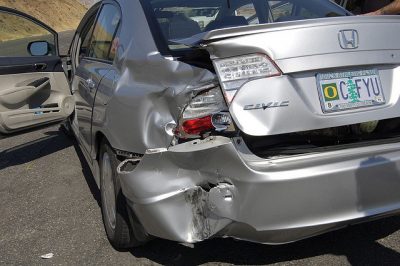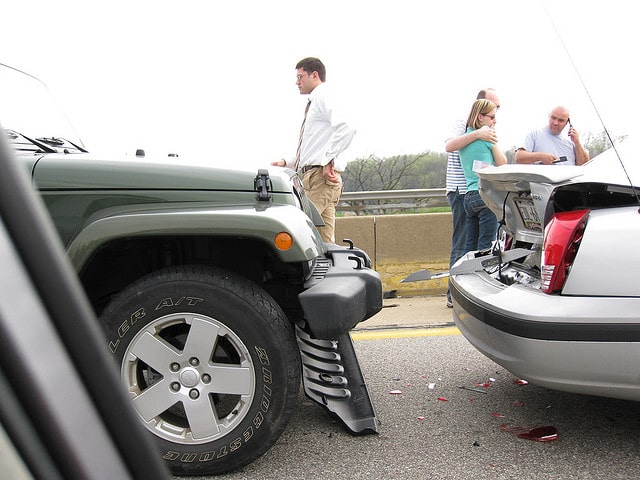 What’s one thing all drivers on the road have in common? We’re all trying our best to avoid an accident. One step to becoming a better driver and avoiding accidents is being aware of the types of accidents and what you can do to minimize your chances of causing them.
What’s one thing all drivers on the road have in common? We’re all trying our best to avoid an accident. One step to becoming a better driver and avoiding accidents is being aware of the types of accidents and what you can do to minimize your chances of causing them.
Table of Contents
Rear-end Collisions
- A rear-end collision is defined as the front of a vehicle crashing into the back of another vehicle. It is also commonly known as a fender-bender.
- According to the National Highway Traffic Safety Administration, 29.6% of vehicle crashes are rear-end collisions.
- A rear-end collision usually occurs because the vehicle that hits the car from behind cannot break fast enough.
- Officials almost always cite the at-fault driver as the one who hit the other from behind. This is the case because if you can’t break before you hit someone from behind, you were probably tailgating the other car.
How to Avoid Them
- Be sure to regularly look ahead of the traffic. This will alert you of any areas that are slowing down; therefore, you can be prepared to hit your brakes.
- Slow down gradually at stoplights or red lights. This will alert the driver behind you to slow down as well.
- Don’t tailgate. Count to 4 seconds between objects that the car in front passes with their bumper and the front of your car. This will assure that you are not following too closely.
- Make sure to check on your rear lights regularly. These lights alert drivers that you are hitting your brake and signal to them that they should hit their brake too.
- When you are stopped with a vehicle in front of you, make sure to leave adequate space between the two. The closer to them you get, the higher chances you have of hitting them in case you mistake their acceleration.
Side-Impact Collisions
- A side-impact collision is defined as one vehicle hitting the side of another vehicle. It is also known as “t-boning.”
- According to the National Highway Traffic Safety Administration, 28.9% of vehicle crashes are side-impact crashes.
- A side-impact collision usually occurs when a car runs a red light.
How to Avoid Them
- Be sure to look both ways before continuing through any intersection, even ones with traffic lights. You never know when a driver will speed up to try and catch a yellow light.
Head-on Collisions
- A head-on collision is defined as two vehicles hitting each other’s front hoods or when a vehicle hits a stationary object with the front of their car.
- According to the National Highway Traffic Safety Administration, 2% of vehicle crashes are head-on collisions.
How to Avoid Them
- If you notice an oncoming car in your lane, slow down immediately. Try to move your car to the right if possible.
- The right lane is safest in case you have to pull over to the shoulder.
- If you are going to hit something regardless, try to go for a stationary object vs. another vehicle. A stationary object isn’t hitting you with any momentum, which lessens the risk.
Sideswipe Collisions
- A sideswipe collision is when two vehicles are driving parallel to each other and one (or both) lean into the other’s lane, therefore swiping the other.
- According to the Insurance Institute of Highway Safety, there are 242,000 sideswipe crashes a year.
How to Avoid Them
- Be sure to check your mirror, signal, AND check your blind spot before shifting lanes.
- Focus on staying in your lane. If you have to dip into another lane for whatever reason, make sure there is not a car to the side of you.
General Advice On Avoiding Accidents
- NEVER drink and drive. Drunk drivers are risking their lives and the lives of others on the road. Call a loved one or a cab to pick you up if you have been drinking.
- If you are tired, pull over.
- Stay focused on the road ahead of you and be patient.
- Stick to the speed limit or ride with traffic.
- Eliminate outside distractions (texting, grooming, eating). Driving is a serious task and should be treated as such.
At Good Guys Injury Law, we understand that even the most careful drivers can be victims of a car accident. If you find yourself in a situation where you were injured in an accident through no fault of your own, call our office to set up a free consultation.
Sources: Wheels.ca, The Zenith, eHow, U.S. Department of Transportation, Greenberg Stong & Urbano
Photo Credit: Anne Jacko via Creative Commons and daveynin via Creative Commons
